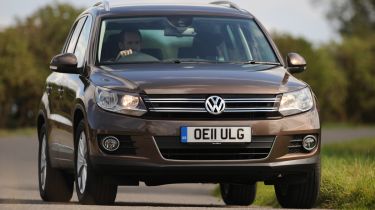VW Tiguan 2.0 TDI 140 SE
Will revisions push this 4x4 back to the top of the compact SUV sector?
Dependability, desirability, GTIs and the Beetle; these are all things that we associate with VW. But until the Touareg and Tiguan came along, the firm didn’t really have much off-road heritage. That makes the success of its smallest 4x4 an impressive achievement, as the Tiguan’s sharp handling and low running costs have made it a popular compact SUV – VW has shifted 600,000 worldwide.
The revised model hasn’t changed much, but that’s hardly a surprise. There wasn’t much wrong with the original, and the latest round of design tweaks reflects this. A Touareg-inspired face is the biggest change, yet existing owners will be familiar with the new Tiguan’s compact and stubby proportions.
Video: watch CarBuyer's video review of the VW Tiguan
[[{"type":"media","view_mode":"content_narrow","fid":"68700","attributes":{"alt":"","class":"media-image"}}]]
Its new front end looks a little droopy to our eyes, but this is unlikely to put anyone off and is the perfect antidote to the look-at-me styling of the Kia. As before, there’s also a Tiguan Escape for buyers who wish to venture off-road. Its redesigned lower bumper gives a chinless appearance, but it’s less likely to get damaged and allows the VW to cope with steeper angles of approach than the regular model in our test.
Used - available now

2024 Volkswagen
Golf GTD
10,576 milesAutomaticDiesel2.0L
Cash £26,697
2022 Nissan
Qashqai e-POWER
34,007 milesAutomaticPetrol1.5L
Cash £17,997
2020 Jaguar
XF
43,266 milesAutomaticDiesel2.0L
Cash £14,460
2020 Land Rover
Range Rover Evoque
60,000 milesAutomaticDiesel2.0L
Cash £17,995Inside, there is little difference between the two derivatives. The Tiguan is shorter and narrower than its Kia rival, but its taller roofline and more upright seating ensures there’s plenty of head and legroom. And versatility is boosted by useful MPV-style sliding rear seats.
Quality is first-rate inside, with plenty of classy trim materials and solid switchgear, while the simple dash features attractive circular air vents. Style-conscious buyers who haven’t been put off by the Tiguan’s conservative exterior will be pleasantly surprised, but the Sportage’s interior is more distinctive.
It sets new standards for Kia cabin quality, so the VW isn’t the runaway leader it once was.
Sliding back seats in the Tiguan make it a family-friendly choice. If you’re carrying older children or adults you’ll want these in their rearmost setting, which leaves you with a 438-litre boot.
If you need more load space and don’t mind reduced rear legroom, sliding them forwards by up to 16cm increases the boot volume to as much as 542 litres. In contrast, the Kia, with its fixed back seats, has a 465-litre load area. The official capacity figure quoted for the Sportage is 564 litres but this is misleading, as it has been achieved by measuring to the roofline rather than the luggage cover.
The Tiguan uses Volkswagen’s tried-and-tested 138bhp 2.0-litre TDI diesel, which is a close match for the Kia’s motor. Longer gearing and a slightly heavier kerbweight take the edge off its performance, as the Sportage was quicker across the board on test, yet the way the Tiguan drives is impressive. Few compact SUVs deliver genuinely car-like dynamics, but the VW does.
Around town the smooth and torquey engine is in its element. It’s quiet at idle and the stop-start system (the Kia has none) works unobtrusively. We would like to see a Peugeot-style counter on the trip read-out that tells you how long the motor has been switched off during each journey, but this is just nitpicking.
Visibility out is excellent, and the suspension strikes a fine balance between comfort and handling. At low speeds it deals with rutted and potholed surfaces easily – you barely have to slow down for speed humps – and when the traffic thins out and you find yourself on more testing roads, the Tiguan raises its game.
It tackles corners with the verve of a good family hatch, with better front-end bite from its tyres than the Kia and less body roll through corners. The steering is also more weighty and confidence-inspiring than in the less composed Sportage.
Traction is predictably strong, and the Tiguan’s stability in our brake tests, where it out-performed the Kia in every measurement, underlines its dynamic superiority.
In BlueMotion Technology form we expected the German machine to be equally dominant at the pumps. While our test car’s 36.9mpg return was OK, it wasn’t good enough to beat the Kia’s impressive 37.7mpg.
The Volkswagen’s official CO2 output of 150g/km is lower than its rival’s in this head-to-head, yet the outcome of this test is no mere formality for the talented Tiguan.
Details
Chart position: 2
WHY: The Tiguan used to be one of our favourite machines in the compact SUV sector. And now, the latest round of revisions bring it into line with its big brother, the Touareg.







